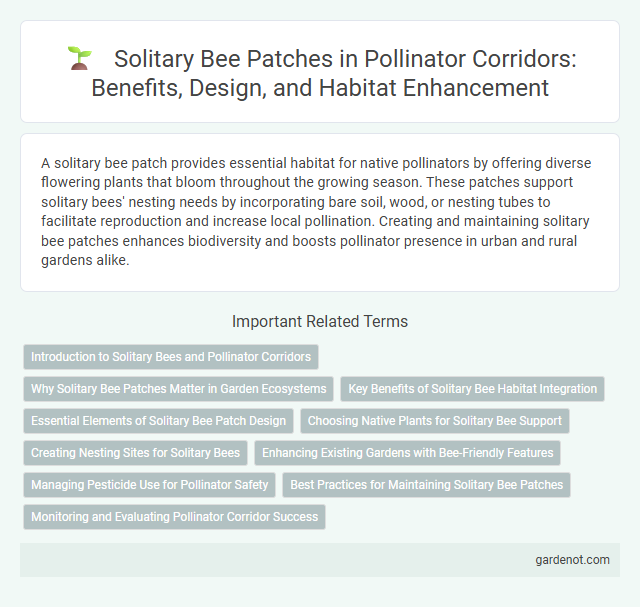A solitary bee patch provides essential habitat for native pollinators by offering diverse flowering plants that bloom throughout the growing season. These patches support solitary bees' nesting needs by incorporating bare soil, wood, or nesting tubes to facilitate reproduction and increase local pollination. Creating and maintaining solitary bee patches enhances biodiversity and boosts pollinator presence in urban and rural gardens alike.
Introduction to Solitary Bees and Pollinator Corridors
Solitary bees, representing over 90% of bee species, play a crucial role in pollination within pollinator corridors by independently fertilizing plants without forming colonies. Pollinator corridors enhance biodiversity by connecting fragmented habitats, allowing solitary bee populations to thrive and efficiently pollinate native flora. Establishing solitary bee patches with diverse flowering plants supports essential ecosystem services and improves crop yields across agricultural landscapes.
Why Solitary Bee Patches Matter in Garden Ecosystems
Solitary bee patches provide essential nesting and foraging habitats that support the survival of key pollinators crucial for garden ecosystems. These bees enhance plant reproduction and increase biodiversity by efficiently pollinating a wide variety of flowers, fruits, and vegetables. Establishing solitary bee patches helps maintain ecological balance and promotes healthy, productive gardens through natural pollination services.
Key Benefits of Solitary Bee Habitat Integration
Integrating solitary bee patches within pollinator corridors significantly boosts biodiversity by providing essential nesting and foraging resources tailored to solitary bee species. These habitats enhance pollination efficiency, supporting crop yield improvements and ecological balance. Creating diverse floral compositions and nesting structures facilitates solitary bee population growth, contributing to resilient and sustainable ecosystems.
Essential Elements of Solitary Bee Patch Design
Solitary bee patches require a variety of native flowering plants that bloom sequentially throughout the growing season to provide continuous nectar and pollen sources. Incorporating diverse nesting habitats such as bare soil, dead wood, and hollow stems supports the differing nesting preferences of solitary bee species. Properly designed patches also avoid pesticide use and maintain nearby water sources to ensure a safe, sustainable environment for bee health and reproduction.
Choosing Native Plants for Solitary Bee Support
Selecting native plants such as wild lupine, milkweed, and goldenrod creates ideal solitary bee patches that provide essential pollen and nectar sources throughout their active seasons. Native flora supports the specific foraging habits and nutritional needs of solitary bees, enhancing their reproductive success and population stability. Incorporating diverse native species in pollinator corridors strengthens ecosystem resilience and promotes sustainable solitary bee habitats.
Creating Nesting Sites for Solitary Bees
Creating nesting sites for solitary bees involves providing bare soil patches, hollow stems, and wood cavities that mimic their natural habitats. These microhabitats support diverse species such as mason bees and leafcutter bees, enhancing pollinator corridor effectiveness by increasing local bee populations. Properly maintained solitary bee patches improve pollination rates in nearby crops and native plants, contributing to ecosystem health and biodiversity.
Enhancing Existing Gardens with Bee-Friendly Features
Integrating solitary bee patches into existing gardens significantly boosts local pollinator populations by providing essential nesting habitats tailored for native bee species like mason and leafcutter bees. Incorporating features such as bare soil patches, hollow stems, and untreated wood creates ideal conditions for solitary bees to nest and reproduce. Enhancing garden diversity with native flowering plants ensures a continuous nectar and pollen supply, supporting the solitary bee lifecycle throughout the growing season.
Managing Pesticide Use for Pollinator Safety
Managing pesticide use in solitary bee patches requires selecting pollinator-friendly products and applying them during low-activity periods to minimize exposure. Use of organic or less-toxic insecticides such as neem oil can reduce harm to solitary bees while controlling pests effectively. Implementing buffer zones and integrated pest management promotes a healthier habitat, ensuring the safety and population sustainability of native solitary bee species.
Best Practices for Maintaining Solitary Bee Patches
Maintaining solitary bee patches requires planting a diverse mix of native flowering plants that bloom sequentially from early spring to late fall to ensure continuous nectar and pollen sources. Keeping the patch free from pesticides and minimizing soil disturbance preserves essential nesting habitats for ground-nesting solitary bees. Regularly removing invasive species and providing bare, well-drained soil patches enhance habitat suitability and support robust solitary bee populations.
Monitoring and Evaluating Pollinator Corridor Success
Monitoring solitary bee patches within pollinator corridors involves regular surveys of bee species diversity, population density, and nesting activity to assess habitat suitability. Evaluating pollinator corridor success requires tracking changes in solitary bee reproductive rates and foraging behavior, which serve as indicators of ecological health and corridor effectiveness. Data collected supports adaptive management strategies to enhance habitat quality and ensure sustainable solitary bee populations.
Solitary bee patch Infographic

 gardenot.com
gardenot.com